In the first post of this series, I talked about legal, financial and personal documents you should consider either bringing with you on the road, or making digital copies of and storing in the cloud, on your smartphone and/or on a flash drive.
This week’s entry deals with appropriate responses and the kind of supplies an RVer should carry to be ready for potential disasters on the road. Since this is a blog about fulltime RV life, that’s the approach I’m writing from. But part-timers could take a page from this playbook, too.
Consider the threats
The first thing we need to think about is what types of disasters we might find ourselves involved in. The list pretty much includes anything that could affect you in a stationary place. What changes are the facts that, in an RV:
- Though you are mobile, you may or may not be able to remove yourself from the affected area, which would lessen your negative impacts.
- If you can’t get away for whatever reason, your home on wheels is more physically vulnerable than a solid, site-built dwelling or other building would be. So you need to be doubly vigilant and prepared.
- You have limited storage space in which to carry your preparedness gear, compared to the relatively unlimited area available in a house or business building, so you must choose wisely.
Informed planning matters
These realities mean that your planning must be that much more detailed, efficient and effective. You must really consider what the most likely threats are, then plan and supply for those, since you won’t have the luxury of being as fully stocked as you might like to be. So, let’s survey the possibilities:
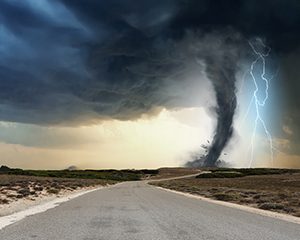 Weather – Depending where you are, this is probably the most likely source of disaster. The most popular RV areas in the continental United States tend to be areas where extreme severe weather is possible: severe thunderstorms, derechos, microbursts, tornadoes, hurricanes, and the floods that they cause. If you tend to stay in the northern states on the fringes of the “shoulder seasons,” you may also make yourself vulnerable to being caught in ice storms and blizzards. For sticks-and-bricks dwellers, these meteorological phenomena may be annoying, inconvenient, even dangerous; but they’re rarely life-threatening. For RVers, though, they could easily and quickly be so. The best defense against getting caught in deadly winter weather is simply to avoid locations north of the Mason-Dixon line any time before mid-April or after early October.
Weather – Depending where you are, this is probably the most likely source of disaster. The most popular RV areas in the continental United States tend to be areas where extreme severe weather is possible: severe thunderstorms, derechos, microbursts, tornadoes, hurricanes, and the floods that they cause. If you tend to stay in the northern states on the fringes of the “shoulder seasons,” you may also make yourself vulnerable to being caught in ice storms and blizzards. For sticks-and-bricks dwellers, these meteorological phenomena may be annoying, inconvenient, even dangerous; but they’re rarely life-threatening. For RVers, though, they could easily and quickly be so. The best defense against getting caught in deadly winter weather is simply to avoid locations north of the Mason-Dixon line any time before mid-April or after early October.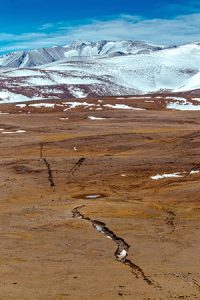 Other Natural Disasters – Wildfires, dust storms, tsunamis, volcanic eruptions/lahars, avalanches and landslides, earthquakes, insect swarms/infestations. Unlike weather, these phenomena are not ones you can easily anticipate. Yes, you can stay out of areas of known seismic activity, but fracking activities are causing earthquakes in places that never had them before the past decade. Wildfires can start any time, anywhere there is combustible fuel and dry enough weather conditions. A hot, dry wind just exacerbates the potential. Dust storms are another thing that rarely happen, but when they do, they can last long enough to be very destructive if not deadly. And they can occur anywhere that’s been under drought conditions for extended periods of time, and where long fetches of high wind are possible. That covers pretty much the entire continent west of the Mississippi River. Insect swarms, though annoying and scary, are usually fairly short-lived and very regional in nature. But you never know when one might crop up, though most of the annual or otherwise regular ones do have a schedule that scientists know about. Also, these swarms are more likely to be uncomfortable than dangerous, but it’s still good to keep them on your radar.
Other Natural Disasters – Wildfires, dust storms, tsunamis, volcanic eruptions/lahars, avalanches and landslides, earthquakes, insect swarms/infestations. Unlike weather, these phenomena are not ones you can easily anticipate. Yes, you can stay out of areas of known seismic activity, but fracking activities are causing earthquakes in places that never had them before the past decade. Wildfires can start any time, anywhere there is combustible fuel and dry enough weather conditions. A hot, dry wind just exacerbates the potential. Dust storms are another thing that rarely happen, but when they do, they can last long enough to be very destructive if not deadly. And they can occur anywhere that’s been under drought conditions for extended periods of time, and where long fetches of high wind are possible. That covers pretty much the entire continent west of the Mississippi River. Insect swarms, though annoying and scary, are usually fairly short-lived and very regional in nature. But you never know when one might crop up, though most of the annual or otherwise regular ones do have a schedule that scientists know about. Also, these swarms are more likely to be uncomfortable than dangerous, but it’s still good to keep them on your radar.- Man-Made Disasters – Hazardous waste leaks, toxic substance explosions, terrorist attacks. The best part of these is that they’re extremely rare, and only one of them is intentional. That intentional one is also highly unlikely to occur anywhere you’re RVing, because terrorists choose urban areas, where the most mayhem can ensue. But those first two are actually more likely to occur near RV parks and campgrounds, because both tend to involve transportation of the truck or railroad kind, and campgrounds tend to be located outside major urban areas in the same places railroads and highways are.
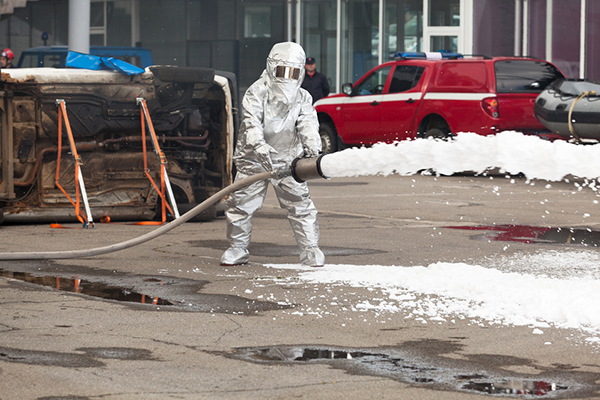
Appropriate response and supplies
Your response to severe weather threats should be three-fold, in this order:
- Avoid
- Seek shelter
- First Aid if necessary
Avoid – To avoid weather disasters, there are some pretty specific strategies you can employ, which are listed below. Unfortunately, you really can’t avoid the other types of disasters other than to stay out of areas where they are known to occur. They happen when and where they happen. If you’re in the wrong place at the wrong time, you’ll simply need to rely on your wits. But you’ll be way more likely to survive if you’ve at least thought about the possibilities and how you might best respond.
Seek Shelter – There are two things you’ll want to protect in the event of disaster: Your bodies and your home, in that order. If you’re on the road when you encounter disaster conditions, you will likely have only moments to react. The natural survival instinct will kick in and you’ll do what you can to stay safe. If you’re camped, you’ll need to have plans for how to respond.
First Aid – This most often requires that you carry, organize and have available a collection of medical and other supplies to treat any injuries and fill immediate wellness needs. Though different types of disasters can require specific equipment, there is a core of first aid supplies you should always have on hand, even for everyday types of emergencies. I recommend a soft-sided bag rather than a hard box to house your kit, as they’re lighter and easier to pack in an RV.
Disaster-Specific Response
Weather Disasters
Avoid – Obviously, the best way to deal with severe weather threats is to avoid them altogether. This is far easier for RVers because we are on wheels and can easily move out of threatened region until the danger has passed. This is possible for long-lead phenomena such as hurricanes and blizzards. But what about those more spontaneous events such as severe thunderstorms, tornadoes, derechos, microbursts and dust storms, that seem to just pop up?
Well, they don’t, really. Each of these phenomena requires a specific set of atmospheric conditions to develop, but not everyone is a trained meteorologist or even a weather weenie, who can recognize these conditions. So for most folks, it does seem these events just happen whenever.
But the first step in successful avoidance is understanding what those conditions are, which is why I’ve created my RV Weather section on this website. You can visit this area to learn:
- Where the severe-prone areas of the continental U.S. are
- How to recognize severe weather conditions
- How severe weather develops
- How storms turn violent
- Types of clouds to watch for that indicate imminent bad weather
- Warm and cold weather dangers
- How to become weather aware, and what to do when severe weather strikes
- Smartphone apps that can help you know the long-term and short-term forecast and respond appropriately in your RV
Seek Shelter – If you’re traveling when you encounter severe weather, wind is your biggest concern. Nearly all RVs, whether driveable or towable, present high enough physical profiles that they become scary sails in high wind conditions. So the very first thing you should do if encountering storms on the road is to find a safe location to get off the road and maneuver your rig to point into the wind.
This usually means pointing west, but it can occasionally mean north (usually during winter storms) or even east (if you’re on the East Coast during a nor’easter type storm). Heading into the wind not only presents the smallest area of resistance; on towables, most modern designs have angled and/or rounded front ends, making the shape more aerodynamic, lessening the chance that your rig will be blown over.
Facing windward also places what should be the heaviest part of the rig (the hitch on a towable, the engine on most driveables) toward the greatest lifting force. The one exception would be diesel pushers, whose engines are in the rear: These vehicles should be turned so the back end is windward. Regardless your type of vehicle, never allow a storm to slam into it from the broadside if you can help it. That’s how it is most vulnerable to wind rollover.
If you are already stationary and cannot or do not wish to drive out of the threatened area, you should also do what you can to turn your rig into the wind. This may seem like a hassle, especially if you’re all set up and it’s just for a passing storm. But if the storm seems powerful enough, it may be the best choice you ever made, which you’ll discover when your rig is the only one not rolled over in your campground.
Better yet, if you are in a camping area that has RV sites among a stand of trees, it may be worth your while to move your rig there until the storm has passed. The trees will serve as a windbreak and protect your rig. The exception to this would be if the trees look old and weak. In that case, they may actually pose more of a danger to your home by either dropping heavy branches on it, or even toppling completely over onto it. Scout the area underneath the trees. If you see lots of large dropped branches, you’re probably better off staying elsewhere.
There are three tactics to protect the bodies of you, your family and your pets from severe weather.
- If you have time to plan, grab your Go Bag (see next section) and take all loved ones with you to the campground’s storm shelter, which you hopefully asked about when you arrived. Stay there until the “all clear” is signaled by those in charge.
- Grab your Go Bag and gather all loved ones. Load them into your vehicle and drive out of the threatened area, at a 90° angle to the path of the storm, which you can determine by using a weather app that shows projected storm tracks. Get at least ten miles out of the predicted path, and stay away until the storm has passed.
- If you are surprised by the storm, grab your Go Bag and pets if you can and run with your loved ones to a low spot, such as a ditch or culvert. Lay face down with your arms covering your head, and your bodies covering young children or pets, until the storm has passed. Keep in mind that if it’s raining, low spots may quickly fill with runoff and you may be in danger of drowning if you don’t move as soon as the wind is over.
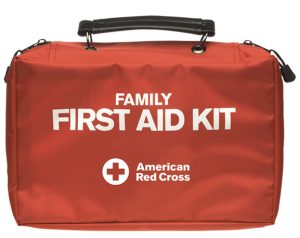 First Aid – First Aid kits for storm recovery generally consist of the same core supplies that should be in any comprehensive kit. Here’s a good list from the Red Cross. Remember that most storm-related injuries concern puncture wounds and blunt-force trauma from flying debris, and stock accordingly. Debris entering eyes is another common problem in severe storms.
First Aid – First Aid kits for storm recovery generally consist of the same core supplies that should be in any comprehensive kit. Here’s a good list from the Red Cross. Remember that most storm-related injuries concern puncture wounds and blunt-force trauma from flying debris, and stock accordingly. Debris entering eyes is another common problem in severe storms.
Other Natural Disasters
Avoid – The best way to avoid wildfires is to stay out of areas where there has been prolonged drought, and where there is an abundance of dry fuel in the surrounding area. Tall grasslands, scrubby brush and forests are all prime fuel just waiting for ignition in a dry season. You can avoid dust storms by staying out of areas that have a lot of loose dirt or sand on the surface, generally areas of desert or high plains. However, that’s not likely, either, for the same reason — these are prime areas where RVers like to camp, and we’re not likely to stay out of them in the off-chance that there may be a dust storm.
You really can’t avoid earthquakes, though your choice of camping spots away from known seismically active areas will help. The same goes with volcanic eruptions, landslides, avalanches and tsunamis. And insect swarms and infestations are usually either freaks or known recurring events. You can stay out of areas where recurring events, such as locust hatches, are known to be upcoming, and simply move out of areas where freak swarms are occurring. The only problem with the latter is that it may not be known where the swarms will head to next, so staying informed is your only real strategy.
Seek Shelter – In a wildfire, if you witness its beginning, immediately check your smartphone to get GPS coordinates and call 911 to report it. Then get out of there, and share the information with any others wherever you are camping. Consider wind direction and if your camp is in its path, don’t wait to find out if it will reach you. Err on the side of caution and relocate to a safe place. These are good responses for all the other natural disasters, as well.
First Aid – If you survive a flash wildfire moving through your camp, first of all, thank your lucky stars. You’re among a choice few. Then assess yourself and others around you for injuries, which may include lacerations, broken bones from falls sustained while trying to escape, and of course, burns.
The first thing to do after a 1st or 2nd degree burn is to run the burn under cool water for 15-30 minutes. If that’s not possible, a cool (not cold) compress is best. Never use ice water or ice packs on burns. They can cause permanent damage.
If you frequently camp in areas where wildfires are a possibility, make sure your first aid kit, along with the core supplies, includes the following:
- Nitrile gloves to keep wounds clean
- Burn spray, gel or cream
- Aloe vera gel – Its lipid component prevents the burn from drying out and accelerates healing.
- Non-stick bandages and sterile pads and gauze; or burn dressings
- Antiseptic spray and wipes
- Antibiotic ointment
- Self-adhesive wrap
- Cotton swabs to clean the wound
- Plastic cling wrap – Produced at very high temperatures, it is sterile. It can be applied directly on top of a 2nd or 3rd degree burn to prevent contamination, because it won’t stick to the burn like dressings will. Cling wrap is also sometimes used instead of a sterile dressing. Because it is clear, the burn may be monitored without having to uncover it. Cling wrap should always be applied in layers, not wrapped. This prevents pressure on the burn if it starts to swell. After applying the cling wrap, wrap it loosely with gauze or self-adhesive wrap to hold it in place.
First aid for the other natural disaster forms may require some or all of these, as well as core first aid supplies.
Man-Made Disasters
Avoid – Two types of man-made disasters—terrorist attacks and shooter incidents—are caused intentionally and generally happen in crowded urban areas. These will only directly impact vandwellers who are stealth camping and happen to be in the immediate vicinity of the event.
However, hazardous waste leaks and toxic substance explosions can occur almost anywhere.
Hazardous waste is generally, but not always, transported via bulk rail car. Smaller loads may occasionally be carried via over-the-road semi-trailers. Though they are required to carry applicable hazardous substance placards, they will not be otherwise labeled, so it’s a good cautious practice to consider all freight vehicles as potentially carrying hazardous materials. This means giving them a wide berth on the road and trying not to park too close to them anywhere.

Train wrecks and derailments and truck accidents are the primary causes of hazardous substance leaks. They can also cause explosions that release these substances into the air, as well as onto surrounding surfaces.
Factories are the secondary source of such explosions and releases. By their very nature, these types of manufacturing facilities are almost always required to be located away from urban areas—in or near many of the same places we like to camp, both in campgrounds and while boondocking. So we are at some risk of being exposed to these types of substances in such a disaster.
The best way to avoid these as much as possible is to do a little homework before choosing your campsite, to make sure you won’t be hard up against train tracks or adjacent to a factory that either uses or produces toxic substances. However, because explosions can disperse these toxins over a wide airborne path if there is an explosion, you may not even need to be in close proximity. So your best bet is to stay tuned in to the local news on a regular basis, especially if you’re boondocking and don’t have camp hosts or neighbors to keep you informed.
Seek Shelter – Almost always, with all of these threats, the best strategy will be to evacuate the area. If you must do so really quickly, grab the family, pets and Go Bag, and jump into your vehicle and get out until they indicate all clear. But if you don’t have a tow vehicle and it will take too long to break camp and get away, you may need to shelter in place. This is when it’s helpful to have things like plastic sheeting, duct tape and respirators. But really, who travels with those things? I don’t, both because I don’t have enough storage space for all that and because I just think the chances of needing it are so remote. You can see why avoidance is the best thing to do in the first place.
First Aid – While you likely won’t ever have to deal with making physical contact with a spilled toxic liquid or solid, you may have the bad luck to be exposed to airborne gases by unwittingly driving into an area where there has been an explosion and authorities haven’t yet had time to evacuate or close off the affected area.
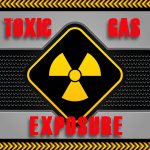 Honestly, there is very little you can do on a first aid basis for someone who has inhaled most toxic gases, unless you are trained in this activity and have the necessary, very specific equipment and know how to use it. That’s just not most of us. Depending on how much gas they’ve inhaled and what type, you’re either looking at getting them to a hospital as quickly as possible, or fairly rapid death.
Honestly, there is very little you can do on a first aid basis for someone who has inhaled most toxic gases, unless you are trained in this activity and have the necessary, very specific equipment and know how to use it. That’s just not most of us. Depending on how much gas they’ve inhaled and what type, you’re either looking at getting them to a hospital as quickly as possible, or fairly rapid death.
Still, there are some things you can do to at least try to mitigate the effects until professional aid becomes available. Here is a list of actions to take in the event of chemical exposure. And here is a more exhaustive list of instructions for chemical ingestion. If you’re really concerned about inhaled toxic gases, you can buy a copy of this book, created by a gas manufacturer to help those responsible for handling such substances.
Part 3 of this series will detail how to create a Go Bag or Bug-Out Bag to serve your unique needs as an RVer.

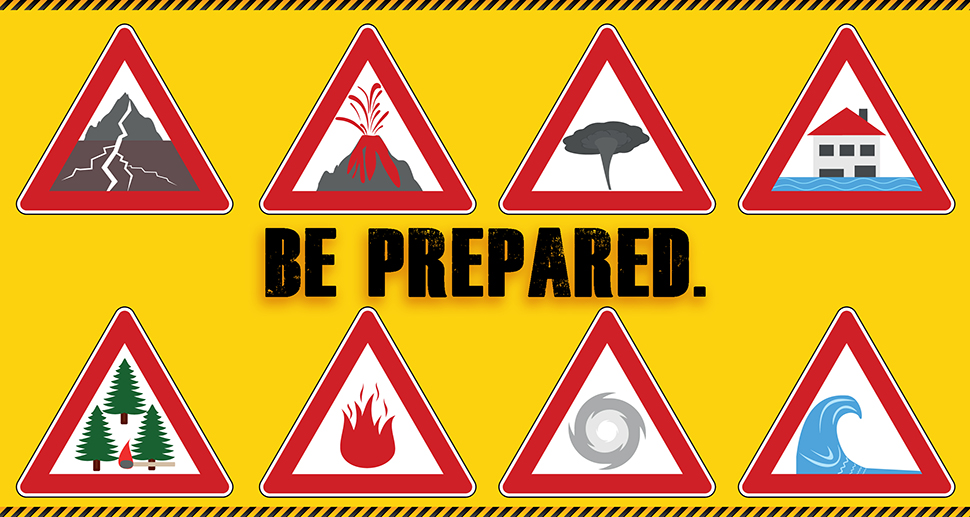
Fantastic information. How wonderful for educating the public travelers, offering info on the risks and great solutions. I am sure this information will save many people a lot of grief and also lives. Bless you kind citizen.
Thanks, MK. I appreciate your feedback, and am glad you find my information helpful!